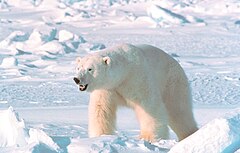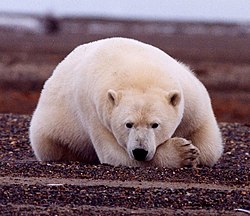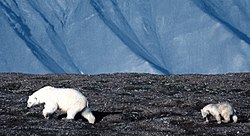Polar bear
- This article is about the animal. For alternative meanings of polar bear, see Polar Bear (disambiguation).
| Polar Bear | |
|---|---|

| |
| Scientific classification | |
| Kingdom: | |
| Phylum: | |
| Class: | |
| Order: | |
| Family: | |
| Genus: | |
| Species: | U. maritimus
|
| Binomial name | |
| Ursus maritimus | |
The polar bear (Ursus maritimus), also known as the white bear, northern bear, or sea bear, is a large bear native to the Arctic. It is the largest land carnivore species and the apex predator within its range. It is well-adapted to its habitat: its thick blubber and fur insulate it against the cold, its white color camouflages it from its prey, and it hunts well both on land and in the water. The polar bear also has a longer neck than other types of bears, though scientists debate why.
Natural range
The polar bear is a circumpolar species found in and around the Arctic Ocean whose southern range limits are determined by pack ice (their southernmost point is James Bay in Canada). While their numbers thin north of 88 degrees, there is evidence of polar bears all the way across the Arctic. Population estimates are generally just over 20,000.[1]
Their main population centers are:
- Wrangel Island and western Alaska
- Northern Alaska
- Canadian Arctic archipelago
- Greenland
- Svalbard-Franz Josef Land
- North-Central Siberia
Their range is limited by the availability of sea ice that they use as a platform to hunt seal, the mainstay of their diet. The destruction of its habitat on the Arctic ice, which may be caused by global warming, threatens the bear's survival as a species; it may become extinct within the century. Signs of this have already been observed at the southern edges of its range.[2]
Size and weight
It is the largest extant species of land carnivore, twice the weight of a Siberian tiger. Most adult males weigh from 400 to 600 kg (880 to 1300 lb) and exceptionally, up to 800 kg (1750 lb). The Kodiak sub-species of the brown bear, an omnivore, is sometimes as large. The largest polar bear on record was shot at Kotzebue Sound, Alaska in 1960. This male was estimated to weigh about 880 kg (1960 lb).[3] Mounted, it stood 3.38 m (11 ft 11 in) high.[4]
Females are about half the size of males and normally weigh 200 to 300 kg (450 to 650 lb). Adult males measure 2.4 to 2.6 m (95 to 102 in); females, 1.9 to 2.1 m (75 to 83 in). At birth, cubs weigh 600 to 700 g.
Subspecies
It is generally believed that there are no living polar bear subspecies.[5] In fact, because "polar bears bred with brown bears have produced fertile hybrids",[6][7] it can be argued that polar bears are a subspecies of Brown Bear.
In May 2006, a hybrid Grizzly-Polar bear was shot in Banks Island, Northwest Territory, Canada. It was later identified as a hybrid, of male Brown and female Polar offspring [8]. Until this point, grizzly-polar hybrids, dubbed "grolar bears" or "pizzlies", have only been found in zoos.
The number of distinct populations depends on who is counting. The IUCN/SSC Polar Bear Specialist Group ("PBSG"), the preeminent international scientific body for research and management relating to polar bears, currently recognizes twenty populations, or stocks, worldwide.[9] Other scientists recognize six distinct populations, but no (living) subspecies:[10]
- Chukchi Sea population on Wrangel Island and western Alaska
- Northern and northwestern Alaska and northwestern Canada (the Beaufort Sea population)
- Canadian Arctic archipelago
- Greenland
- Spitzbergen-Franz Josef Land
- Central Siberia
Other sources list these subspecies:
Fur and skin

A polar bear's nose and skin are black and the fur is translucent despite its apparent white hue. The fur is good camouflage as well as insulation. Stiff hairs grow on the soles of its paws; these insulate and provide traction on ice.
Unlike other arctic mammals, polar bears never shed their coat for a darker shade in the summer. The fur absorbs ultraviolet light. The hair does not have fiber-optic properties nor does it transmit light or heat to the skin (an urban legend). The thick undercoat does however insulate the bears to the point where they overheat at temperatures above 10 °C (50 °F) and are nearly invisible in the infrared; only their breath and muzzles can be seen. [13] Growing through the undercoat is a relatively sparse covering of hollow guard hairs about 6 inches long. These guard hairs are stiff, shiny and erect, and stop the undercoat from matting when wet. The water is then easily shaken off before it can freeze. The bear also rolls in snow to blot up moisture in the coat.
In July 2005, several polar bears in the Brookfield Zoo turned green as a result of algae growing in their hollow guard hair tubes. Chicago experienced an extremely hot, humid and dry summer that year. However, the zoo took no action since it has been shown the algae does not negatively affect the bears in any way. The staff believed that exposing the bears to chlorine or bleach would be more harmful than letting the algae run its course. Previously, in February 2004, two polar bears in the Singapore Zoo turned green due to algae growth. A zoo spokesman said that the algae had formed as a result of Singapore's hot and humid conditions. The bears were washed in a peroxide blonde solution to restore their expected colour. A similar algae grew in the hair of three polar bears at San Diego Zoo in the summer of 1980. They were cured by washing the algae away in a salt solution. In July 2003, the fur of Pelusa, a female polar bear in Argentina's Mendozas Zoo, turned purple for about a month. Drugs given in order to treat a skin infection caused the temporary side effect. [14]
Hunting, diet and feeding
It is the most carnivorous member of the bear family, and the one that is most likely to prey on humans as food. It feeds mainly on seals, especially Ringed Seals that poke holes in the ice to breathe, but will eat anything it can kill: birds, rodents, shellfish, crabs, seals, Beluga Whales, walruses, occasionally Musk Oxen, and very occasionally other Polar Bears.
Polar bears are excellent swimmers and can often be seen in open waters miles from land. This may be a sign that they have begun aquatic adaptations to better catch their prey, although recent evidence indicates that they may be drowning in the open sea because global warming is melting the ice shelves that previously made up their homes.[15] They also hunt very efficiently on land due to their prodigious speed; they are more than capable of outrunning a human. Still, caribou and musk oxen easily outrun a polar bear, and polar bears overheat quickly; thus the polar bear subsists almost totally on seals and on walrus calves or adult carcasses.
As a carnivore feeding largely upon fish-eating carnivores, the Polar Bear ingests large amounts of Vitamin A, which is stored in its liver; in the past, humans have been poisoned by eating Polar Bear liver. Although largely carnivorous, they will also feed on carrion (e.g. beached whales) and also eat some vegetable matter, mainly berries and roots in the late summer, as well as kelp.
Polar bears are aggressive, curious, and extremely dangerous to humans. A polar bear should never be approached and if one is spotted, it is best to retreat slowly on foot, preferably to indoors, or move away in a vehicle.
Regrettably, like other species of bear, they have developed a liking for garbage; the dump in Churchill, Manitoba is frequently scavenged by Polar Bears, who have been observed eating (among other things) grease and motor oil.[16]
Breeding

Polar bears mate in the spring; pairing is temporary, only lasting for the mating with no permanent bond between males and females. The gestation period is 240 days (8 months), with the cubs born in early winter in a cave dug in October by the mother in deep snow. Usually, two cubs are born, less often one or three; litters of four cubs have been recorded. As with other Ursus bears, the cubs are very small at birth, typically 30 cm long and weighing 700 g. The cubs are born nearly helpless and blind, opening their eyes at about one month old, able to walk at 1.5 months, and start eating solid food at 4-5 months. They remain with their mother, learning how to hunt and protect themselves against adult males (which have been known to cannibalize cubs), until 10 months old. Females nurse their young for up to two and a half years on milk that contains approximately 33% fat, higher than that of any other species of bear and comparable to that of marine mammals.[17] Sexual maturity is reached at 3-4 years. Adult polar bears are known to live to over 30 years. Polar bears do not hibernate, though the lactating females will not emerge from their cave while the cubs are very young. The mother will not have eaten for nine months, thus relying on stored body fat also known as blubber for both her own nutrition and that of the cubs.[citation needed]
Phylogeny
The Raccoon and bear families are believed to have diverged about 30 million years ago and around 13 million years ago the Spectacled Bear split from the other bears. The 6 distinct ursine species originated some 6 million years ago. The Brown Bear and Polar Bear diverged from a common ancestor around 2 million years ago and crosses between the two species produce fertile hybrids. They only lost their Brown Bear molars between 10 and 20 thousand years ago.
Entertainment and commerce

Polar Bears have been made both controversial and famous for their distinctive white fur and their habitat. Companies like Coca-Cola, Nelvana, Bundaberg Rum and Good Humor-Breyers have used images of this bear in logos. The Canadian 2-dollar coin (right) features the image of a polar bear. Also, polar bears have appeared on the island featured in the TV drama Lost. The panserbjørne of the fantasy trilogy His Dark Materials are sentient polar bears.
Gallery
-
Three Polar Bears investigate the submarine USS Honolulu 280 miles from the North Pole.
-
Two Polar Bears sparring near Churchill, Manitoba, Canada.
-
Polar Bear tracks at Svalbard
-
Tourists watching Polar Bears from a "tundra buggy" near Churchill, Manitoba
-
Polar Bear cubs
-
Polar Bear at Cape Churchill (Wapusk-Nationalpark, Manitoba, Canada)
-
Two Polar Bears at Cape Churchill (Wapusk-Nationalpark, Manitoba, Canada)
-
Polar Bear in St Petersburg Zoo.
References
Cited references
- ^ http://www.polarbearsinternational.org/bear-facts
- ^ http://www.biologicaldiversity.org/swcbd/species/polarbear/index.html
- ^ Guinness World Records, Guinness World Records 2006, Guinness (August 15, 2005), ISBN 1904994024
- ^ http://www.4to40.com/recordbook/index.asp?category=&counter=476]
- ^ http://www.bbc.co.uk/nature/wildfacts/factfiles/7.shtml
- ^ http://animaldiversity.ummz.umich.edu/site/accounts/information/Ursus_maritimus.html
- ^ http://news.yahoo.com/s/ap/20060511/ap_on_sc/hybrid_bear_3 Report of wild hybrid bear
- ^ http://news.bbc.co.uk/1/hi/sci/tech/4766217.stm
- ^ http://www.biologicaldiversity.org/swcbd/species/polarbear/nat-hist.html
- ^ http://www.polarbearsinternational.org/faq/
- ^ http://www.itis.usda.gov/servlet/SingleRpt/SingleRpt?search_topic=TSN&search_value=622083
- ^ http://www.itis.usda.gov/servlet/SingleRpt/SingleRpt?search_topic=TSN&search_value=622084
- ^ http://www.biologicaldiversity.org/swcbd/species/polarbear/nat-hist.html
- ^ http://news.bbc.co.uk/1/hi/magazine/3094259.stm
- ^ http://www.timesonline.co.uk/article/0,,2087-1938132,00.html
- ^ Ed Struzik. "Nanook: In the tracks of the great wanderer" (1987). Equinox 6 (1): 18–30.
- ^ http://www.biologicaldiversity.org/swcbd/species/polarbear/nat-hist.html
General references
- Bears of the World, Terry Domico, Photographs by Terry Domico and Mark Newman, Facts on File, Inc, 1988, hardcover, ISBN 0816015368
- Arctic Dreams, Barry Lopez, Macmillan 1986, hardcover, ISBN 0-333-42244-9
See also
External links
- ARKive - images and movies of the polar bear (Ursus maritimus)
- Polar Bears turn green in Singapore, a BBC News report
- Polar Bears International, a Polar Bear conservation group
- Sandiegozoo
- Biological Diversity
- The WWF Polar Bear Tracker, follow Polar Bears on Svalbard as they are tracked by satellite.
- Polar Cam, live video of the Polar Bear exhibit at the San Diego Zoo. Online daily between 09:00 – 16:00 UTC-8 (or UTC-7 during Daylight saving time)
- The Polar Bear Cam, live video and images from the Polar Bear migration near Churchill, Canada. Online during October and November only.
- Video of Polar Bears on YouTube
- Pictures of Polar Bears on the island of Spitsbergen
- CBC News article on possible "grolar bear" (Polar Bear/Grizzly Bear hybrid)
- Polar Bear (Thalarctos maritimus) facts and picture - Wild Animals Online encyclopedia
- Global Warming Issues
- Folly to predict polar bears' fate — Toronto Star, May 3 2006
- List the Polar Bear as a Threatened Species under the Endangered Species Act
- Starving polar bears shame Bush to act
- Global warming has U.S. rethinking polar bear status
- The Polar Bear and the Global Warming
- Working & Travelling in areas populated by Polar Bears







